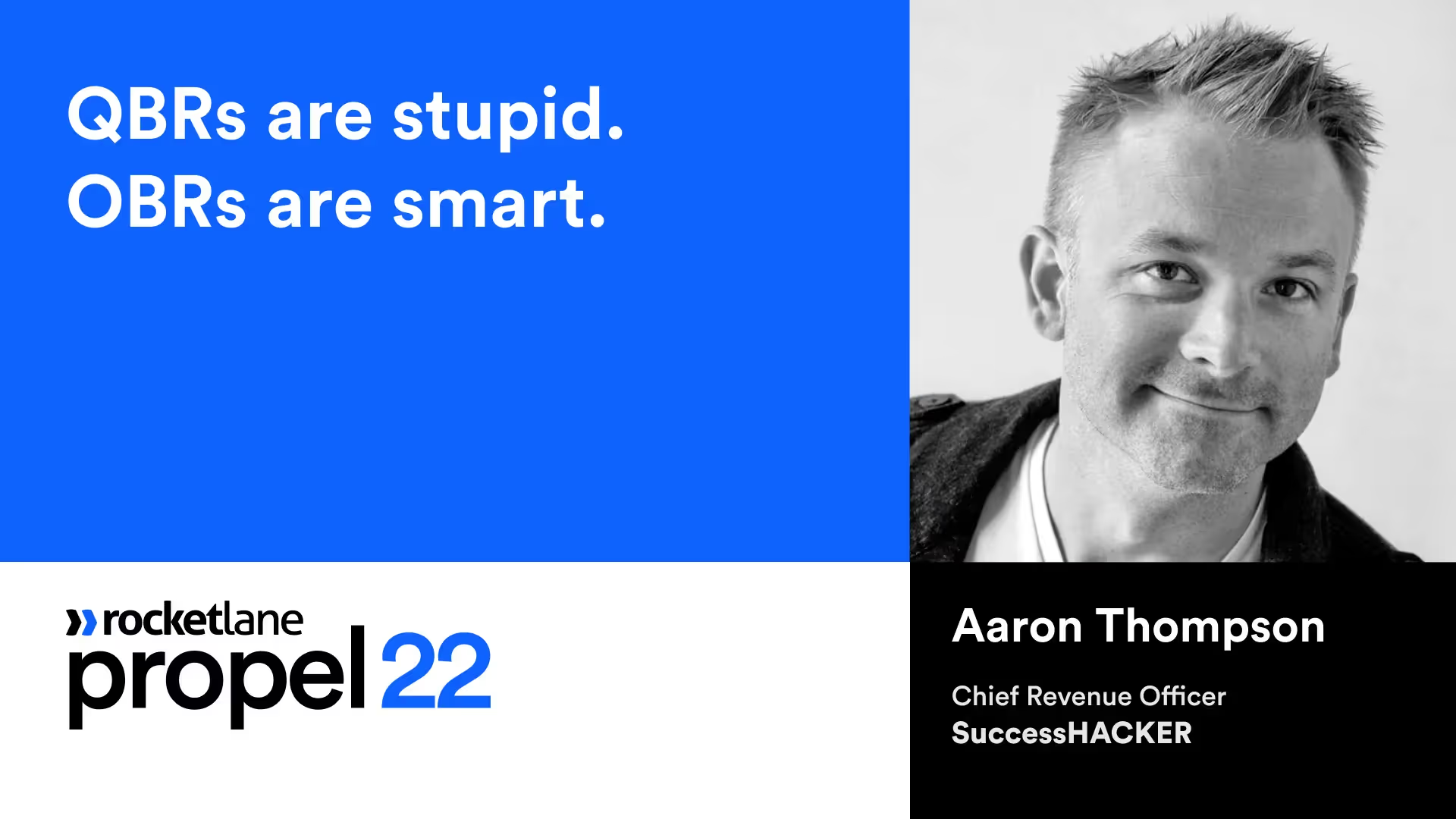Aaron Thompson, Chief Revenue Officer at Success Coaching, presented his findings on why Quarterly Business Reviews (QBRs) are stupid and Onboarding Business Reviews (OBRs) are smart.
He spoke about:
- Why QBRs are stupid
- What an OBR is
- When to deliver an OBR
- The impact OBRs have on revenue
- An auditing template to begin building your first OBR
Here are some of the key takeaways from Aaron's session.
Why QBRs are stupid
QBRs are a consistently delivered event. We tend to drag our executive sponsors into these quarterly meetings that they don't necessarily want to attend. Our goal is to identify our customer's business goals and desired outcomes for onboarding. They've got pains to relieve, gains to achieve, or maybe both.
When we develop these outcomes with our customers, we can use the business review to identify those goals and align them with how we will help them achieve them. Your customers don't care about your product; they care about what it does for them; it's a tool to achieve some outcome. And our goal is to support them in achieving those goals. That's why business reviews should be 100% strategic, not tactical.
It's excellent for your customers to want to talk about support, tickets, or bugs. But that's not a business review. That's a tactical conversation. And we're there to talk again about their business goals. What have we helped them accomplish? And what are we going to help them accomplish next? The frequency of these meetings should change and not just be quarterly.
"Your customer's life is not consistent. It has cycles; there are times when they are busy and don't want to talk to you. But they are more open to sitting down and having that strategic conversation. But to try and force a quarterly cadence is just foolish. And I am begging the whole customer success industry to rid ourselves of this friction-filled experience of a QBR."
What is an OBR?
We can define a new type of meeting called an Onboarding Business Review (OBR) instead. Remember that this is an inconsistently delivered event. And it doesn't have to be a meeting. We can get creative with how we can do this. The idea is that we're going to do this once as they exit onboarding to review what we've done collectively so far.
Customers can't get value if they don't get onboarded. So whatever you do to get there, make sure to celebrate that. Then look at the future and how you're moving regarding the overall outcomes you're helping your customers achieve. And that takes us to the next point - we're going to identify their business goals.
CS (Customer Success) = CO (Customer Outcomes) + CX (Customer Experience)
We're then going to align with customers around how we can help them achieve those desired outcomes. Now let's look at what an Onboarding Business Review looks like when completed. QBRs are 100% strategic and 0% tactical. But an OBR is slightly different because we're going to talk about the COs, your strategic initiatives, and then we're going to talk about the CXs, which are your tactical stuff. Once you and your customer get to an agreed definition of success (the North Star), it's just a matter of demonstration. It is a 100% future planning process. We're getting to know them, their people, their process, and we're getting to know their desired outcomes and experiences.
When to deliver an OBR
The top of the funnel is your marketing team, they'll be doing your demand generation and awareness, outbound, inbound, webinars, blog posts, etc. The green in the middle is your sales team shepherding the evaluation process and ultimately helping customers decide if you are the right vendor or solution for the pain they're looking to solve.
Then we move into customer success. The "activate" stage is your onboarding experience, and "optimize" is when you are about 180 days into the journey. We get to the "renewal" stage when we do the three Ds effectively (Define, Deliver, and Demonstrate value). If your customers know without a shadow of a doubt the value they are getting, and if you are delivering their definition of success, they will renew.
And that's when the OBR should be delivered. Right as they're exiting activation and entering their optimized stage. The onboarding business review will discuss what we've done together so far and then align on the future vision.

The impact OBRs have on revenue
If you deliver the three Ds (defining, delivering, and demonstrating value) effectively to your customers, it will lead to expansion because you will be their trusted advisor. They will not doubt the value they are getting. Hence, it will be in their best interest to buy more, use more, and spend more.
So your expansion revenue is going to increase as you're more outcome aligned with everything you do.
There's are three revenue streams that will be positively affected by implementing an Onboarding Business Review - higher retention, greater expansion, and more Net New Revenue.
The five goals Of OBRs
- Understand your customer's needs
- Agree on a common definition of success
- Educate and motivate the users
- Manage change effectively
- Reinforce the value promise

An auditing template to begin building your first OBR
Feel free to make a copy of the following template. As you go through it and audit your organization, you will most certainly identify gaps in your processes and places to improve and reduce friction in your onboarding experience. This process can be done as part of your Onboarding Business Reviews.
















